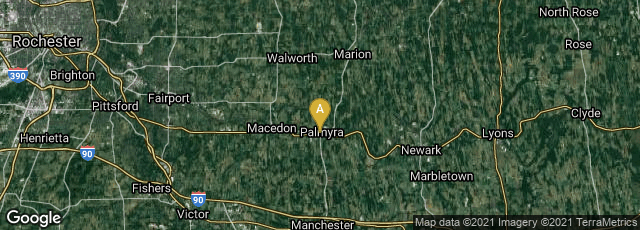

A: Palmyra, New York, United States
From the Brigham Young University Religious Studies Center article by Keith J. Wilson entitled "From Gutenberg to Grandin: Tracing the Development of the Printing Press" we learn:
"The Smith press had a platen of about 21x30˝. Sixteen pages were typeset and printed with each pull of the press lever. This meant that for a 592-page book with a run of 5,000 copies, approximately 2,960,000 pages had to be printed. In layman’s terms, the printing lever on this rugged Smith press would have been pulled at least 185,000 times during this seven-month period. It would have necessitated more than a thousand pulls per day.
"But this was not all. To print each sheet of paper, two skilled pressmen had to quickly perform nine other separate tasks. After the printing pull, these other nine steps were as follows: crank the bed back to its original position, lift up the frisket assembly, lift the frisket bracket and remove the sheet, hand ink all sixteen pages in the composite layout, lift the frisket bracket, register the sheet on the timpan bracket, lower the frisket bracket back into place, swing the frisket basket down on the inked layout, and crank the removable bed under the platen. Completing these tasks meant that one of the 185,000 pulls had been completed. On a daily basis, these tasks had to be repeated more than one thousand times. [44] However, this printing procedure constituted only a fraction of the effort to actually produce the book. The type and spacers, which totaled over 42,500 individual pieces for each form, had to be typeset thirty-seven different times. (The total number of pieces set during the seven months was more than 1.5 million.) The entire manuscript also had to be punctuated by the typesetter. [45] Next, the printed sheets had to be hung and dried, after which the thirty-seven signatures were folded, cut apart, and stitched together for each book. Finally, a binding was applied to the 592 pages. [46] For a small frontier newspaper, this 184-day process was nothing short of phenomenal."
On March 26, 1998, the anniversary of the first printing, The Church of Jesus Christ of Latter-day Saints (LDS Church) dedicated a restoration of part of the original Grandin printing establishment in Palmyra, NY, which the church maintains and where it offers free guided tours.
On September 18, 2017, the LDS Church purchased the Cowdery manuscript used by Grandin. The church bought the manuscript from the Independence, Missouri-based Community of Christ for a reported price of $35 million. The Community of Christ, formerly the Reorganized Church of Jesus Christ of Latter Day Saints, had owned the manuscript since 1903.[18](Wikipedia article on E. B. Grandin, accessed 1-2021).